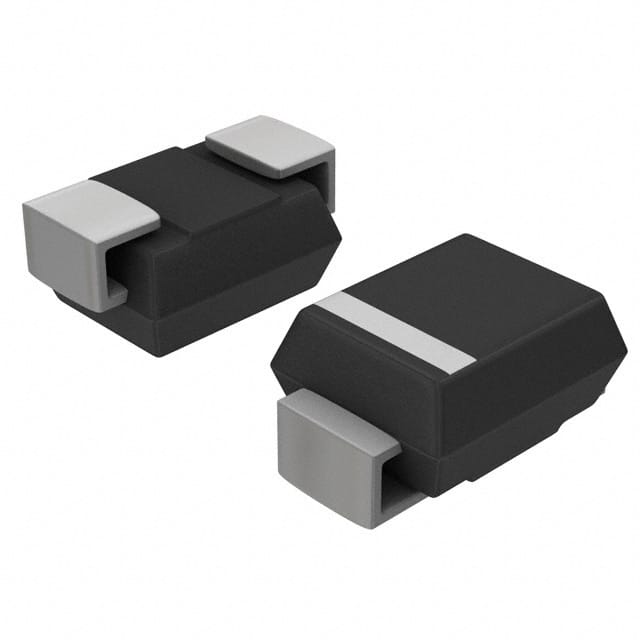MSMCJ16CAE3
Product Overview
- Belongs to: Semiconductor devices
- Category: Diode
- Use: Protection against voltage transients in electronic circuits
- Characteristics: Low leakage current, fast response time, high surge capability
- Package: SMC (Surface Mount Compatible)
- Essence: Transient Voltage Suppressor (TVS) diode
- Packaging/Quantity: Tape & Reel, 3000 units per reel
Specifications
- Peak Pulse Power: 1500W
- Breakdown Voltage Range: 15.3V to 16.7V
- Operating Temperature Range: -55°C to +150°C
- Reverse Standoff Voltage: 13.6V
- Forward Voltage: 3.5V at 10A
Detailed Pin Configuration
- Pin 1: Anode
- Pin 2: Cathode
Functional Features
- Provides protection against transient voltage events
- Fast response time ensures minimal damage to the protected circuit
- Low clamping voltage for improved system reliability
Advantages and Disadvantages
Advantages
- High surge capability
- Low leakage current
- Compact SMC package for space-constrained applications
Disadvantages
- Limited breakdown voltage range compared to some alternatives
- Higher forward voltage compared to some alternatives
Working Principles
The MSMCJ16CAE3 operates by diverting excess current away from sensitive components when a transient voltage event occurs. It rapidly clamps the voltage to a safe level, protecting the downstream circuitry.
Detailed Application Field Plans
- Telecommunications: Protects sensitive communication equipment from voltage surges
- Automotive: Safeguards electronic systems in vehicles from voltage transients
- Industrial Control Systems: Ensures reliable operation of control electronics in industrial environments
Detailed and Complete Alternative Models
- Alternative 1: SMBJ16CA
- Category: Diode
- Use: Voltage transient protection
- Characteristics: Lower surge capability, smaller package size
- Alternative 2: P6KE16CA
- Category: Diode
- Use: Transient voltage suppression
- Characteristics: Higher surge capability, axial lead package
This completes the entry for MSMCJ16CAE3, providing comprehensive information on its category, use, characteristics, specifications, pin configuration, functional features, advantages and disadvantages, working principles, application field plans, and alternative models.
10个与MSMCJ16CAE3在技术解决方案中的应用相关的常见问题及解答
What is MSMCJ16CAE3?
- MSMCJ16CAE3 is a transient voltage suppressor diode, commonly used to protect sensitive electronics from voltage spikes and transients.
What is the maximum clamping voltage of MSMCJ16CAE3?
- The maximum clamping voltage of MSMCJ16CAE3 is 25.6V at 16A.
What is the peak pulse current rating of MSMCJ16CAE3?
- The peak pulse current rating of MSMCJ16CAE3 is 300A.
What are the typical applications of MSMCJ16CAE3?
- MSMCJ16CAE3 is commonly used in surge protection for telecommunications equipment, power supplies, and automotive electronics.
What is the breakdown voltage of MSMCJ16CAE3?
- The breakdown voltage of MSMCJ16CAE3 ranges from 17.8V to 22.2V.
What package type does MSMCJ16CAE3 come in?
- MSMCJ16CAE3 is available in a surface mount DO-214AB package.
What is the operating temperature range of MSMCJ16CAE3?
- The operating temperature range of MSMCJ16CAE3 is -55°C to 150°C.
How does MSMCJ16CAE3 provide overvoltage protection?
- MSMCJ16CAE3 shunts excess current away from sensitive components when an overvoltage event occurs, protecting them from damage.
Can MSMCJ16CAE3 be used in high-speed data lines?
- Yes, MSMCJ16CAE3 is suitable for use in high-speed data lines such as USB, Ethernet, and HDMI interfaces.
Is MSMCJ16CAE3 RoHS compliant?
- Yes, MSMCJ16CAE3 is compliant with the Restriction of Hazardous Substances (RoHS) directive.


